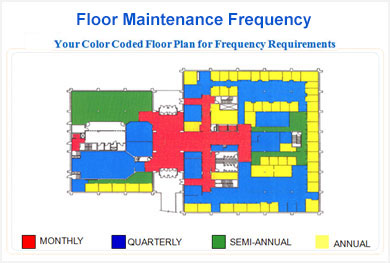Shaw TotalCare - Commercial Maintenance Plan

The purpose of a floor care maintenance plan is to maintain a high-level of appearance at all times, rather than only after infrequent restorative cleaning. Regular, on-going maintenance keeps the floor looking its best, contributes to better indoor air quality, and prolongs the life of the floor, ensuring it won’t need to be replaced prematurely.
Get Your Customized Plan
Determine Cleaning Frequency According to Traffic Flow
Your floor care maintenance plan should be built around traffic flow within the facility. Areas that receive heavier traffic, such as hallways and common entrances, will need more frequent cleaning than areas with less traffic, such as private offices and cubicles.
To accurately determine traffic and cleaning frequency, it is recommended that you start with a detailed floor plan of the facility and use a color-coded system to identify each area.
Sample Maintenance Plan
In the sample floor plan shown here, traffic levels are indicated by different colors, which makes it easy to determine which areas need more attention than others.

The final floor care maintenance plan for this facility may look something like this:
Yellow/Light Traffic
Private offices, cubicles
Carpet:
- Vacuum: 1–2 Times Weekly
- Encapsulation Cleaning: Semi-annual (every 6 months) or as needed
- Deep cleaning: Every six months
Hard Floors:
- Dust mop: 1–2 times weekly
- Wet mop: Every two weeks to every month
- Hot Water Extraction: Annual
Green/Moderate Traffic
Shared offices, conference rooms, classrooms
Carpet:
- Vacuum: Daily
- Encapsulation Cleaning: Quarterly or as needed
- Hot Water Extraction: Semi-annual (every 6 months)
Hard Floors:
- Dust mop: Daily
- Wet mop: Every week
- Hot Water Extraction: Quarterly
Blue/Heavy Traffic
Common areas, elevators, main hallways, break rooms
Carpet:
- Vacuum: Daily
- Encapsulation Cleaning: Monthly
- Hot Water Extraction: Quarterly
Hard Floors:
- Dust mop: Daily
- Wet mop: Daily
- Hot Water Extraction: Monthly
Red/Extra Heavy Traffic
Common entrances, cafeterias
Carpet:
- Vacuum: Daily
- Encapsulation Cleaning: Weekly or as needed
- Hot Water Extraction: Monthly
Hard Floors:
- Dust mop: Daily
- Wet mop: Daily
- Hot Water Extraction: Daily or Weekly
Components of a Successful Maintenance Program
There are three types of cleaning that work together to provide a full maintenance plan that is efficient, cost effective, and designed to increase the useful lifespan of your carpets.
DAILY MAINTENANCE
Vacuuming/Dust Mopping: Carpets should be vacuumed and hard floors dust mopped on a regular basis to remove dirt, dust, hair, food crumbs, and other soiling. Vacuuming and dust mopping should be performed daily in moderate and heavy traffic areas and weekly in light traffic areas.
Spot Removal: Food and liquid spills should be cleaned within 24 hours. Spills that are left untreated for extended periods become more difficult to remove, or they could cause permanent damage to both carpet and hard floors..
INTERIM MAINTENANCE
For carpet cleaning, low-moisture encapsulation systems enable the carpet’s appearance to be improved and returned to service in a short amount of time. Depending on the level of traffic, encapsulation cleaning should be performed weekly, monthly, or quarterly.
For hard floors, wet mopping or cleaning with an auto scrubber or floor machine should be performed periodically to rejuvenate the floor's appearance and remove sticky, stubborn soiling. This should be performed daily, weekly, or monthly, depending on the level of traffic in the facility.
RESTORATIVE MAINTENANCE
For commercial carpet, interim maintenance can be performed 1–4 times before a restorative deep cleaning through hot water extraction is required. Hot water extraction is the most effective way to remove deeply embedded dirt and soiling and achieve the desired results. Depending on the traffic level, hot water extraction may need to be performed monthly, quarterly, semi-annually, or once per year.
For hard floors, a deep cleaning or refinishing of the floor should be performed when interim maintenance methods no longer produce the desired look. When floors become more difficult to clean (e.g., it takes more and more scrubbing to remove heel marks), it's a good indicator that a deep restorative cleaning or refinishing should be done. Depending on the traffic level, this process should be performed monthly, quarterly, semi-annually, or once per year.
Get Your Customized Plan

